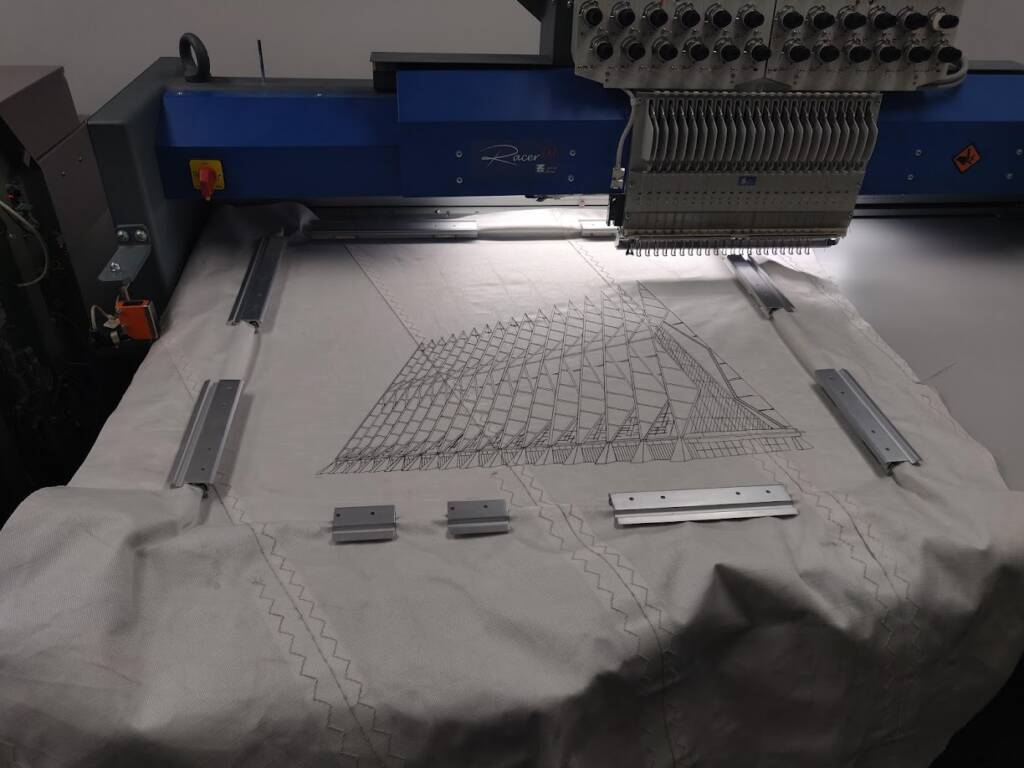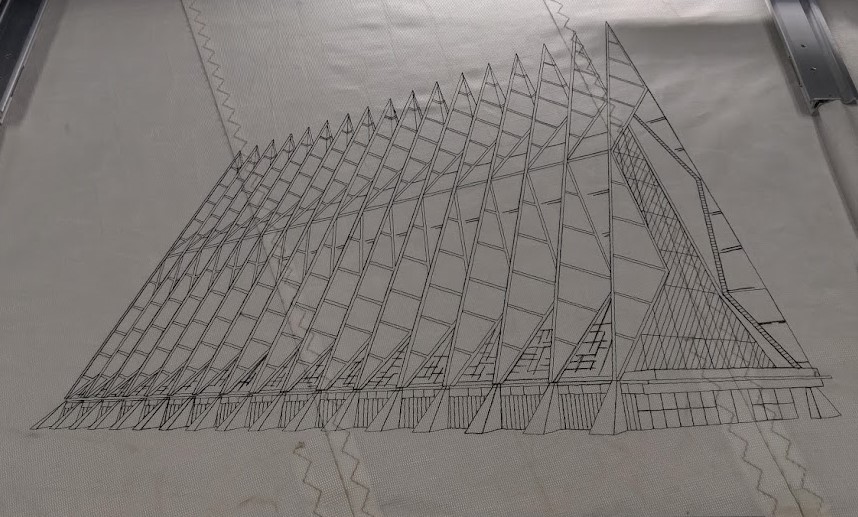Embroidery has long been a celebrated art form, blending precision engineering with creative expression. In this project, I’m using a large-format embroidery machine to produce a fine linework mural, utilizing a style known as blackwork. Blackwork, a traditional embroidery style often characterized by intricate geometric designs or detailed illustrations, relies heavily on fine, continuous lines to achieve its visual impact. Here’s an in-depth look at the process, materials, and techniques used for this endeavor.
The embroidery mural is being created on a large-format embroidery machine capable of stitching within a 24″ x 24″ area. This generous space allows for intricate designs that would otherwise require significant manual effort to achieve.
Stitching Details
To achieve the delicate line quality essential to blackwork, the machine is running at full speed, completing the mural in under 30 minutes. The short production time is a testament to both the efficiency of modern embroidery machines and the meticulous preparation required to ensure precision stitching.
Thread Specifications
For this project, I’m using Amann Isacord 40, a high-quality polyester embroidery thread well-suited to high-speed stitching. The thread’s durability and smooth finish make it an ideal choice for maintaining consistent tension and minimizing breakage.
For this project, I’m using Amann Isacord 40, a high-quality polyester embroidery thread well-suited to high-speed stitching. The thread’s durability and smooth finish make it an ideal choice for maintaining consistent tension and minimizing breakage.
Bobbin tension: Maintained at 32 gF, using pre-wound paper bobbins from Amann. Pre-wound bobbins are known for their uniformity and consistent performance, essential for projects demanding high precision.
Thread weight: 40-weight thread, commonly used in embroidery, equates to approximately 25 Tex (a direct measurement system where lower numbers indicate finer threads). For comparison, Tex is calculated as the weight in grams of 1,000 meters of thread.
Top tension: Set to 90 grams-force (gF) to ensure smooth stitching without puckering or thread breakage.


Material Insights
The mural is being stitched onto a used sail from Seattle sailboat racing. This sail is made from Spectra, a high-tensile material renowned for its exceptional strength-to-weight ratio. Spectra’s unique properties make it a fascinating and challenging material for embroidery:
Thickness: Due to the material’s density and thickness, I’ve opted for a size #70 Groz-Beckert needle, slightly larger than usual. This choice minimizes needle deflection, especially when stitching over the sail’s seams, which are areas of increased resistance.
Durability: Spectra fibers are resistant to wear, UV degradation, and moisture, ensuring the longevity of the stitched mural.
Stability: The material’s stiffness eliminates the need for additional backing, which is typically required to stabilize fabric during embroidery. This stability is particularly advantageous for intricate designs like blackwork.
Made from recycled used sail from Seattle sailboat racing. This material is high quality, high strength, and stable to stitching.
Needle and Tension Considerations
Needle size plays a critical role in embroidery, especially when working with unconventional materials like Spectra. The #70 needle is a compromise between strength and precision, ensuring clean penetration of the fabric without causing damage to the threads or the material itself. Proper needle selection also reduces skipped stitches and thread breaks, which can disrupt the overall flow of the design.
The Art of Blackwork
Blackwork embroidery dates back to the 16th century and remains a popular technique for its simplicity and elegance. In this mural, the fine linework mirrors the precision of technical drawings, achieved through a combination of:
- Straight stitches: To outline and define shapes.
- Fill patterns: For shading and texture. These patterns often rely on geometric shapes like diamonds, zigzags, or crosshatching, providing depth and dimension to the design.
Although blackwork traditionally uses black thread, the principles can be adapted to other colors (e.g., redwork). However, for this mural, I’ve chosen to remain faithful to the classic black-on-white aesthetic.

This project merges traditional embroidery techniques with cutting-edge materials, resulting in a mural that is both visually striking and technically innovative. The use of Spectra sails as a canvas not only showcases the versatility of embroidery but also highlights the sustainability aspect of repurposing high-performance materials.
The embroidery files for this project are available for download. If you’d like to recreate this mural on your machine, please credit topher@arachne.net when sharing your results. I’d love to see how this design inspires your own projects!



